
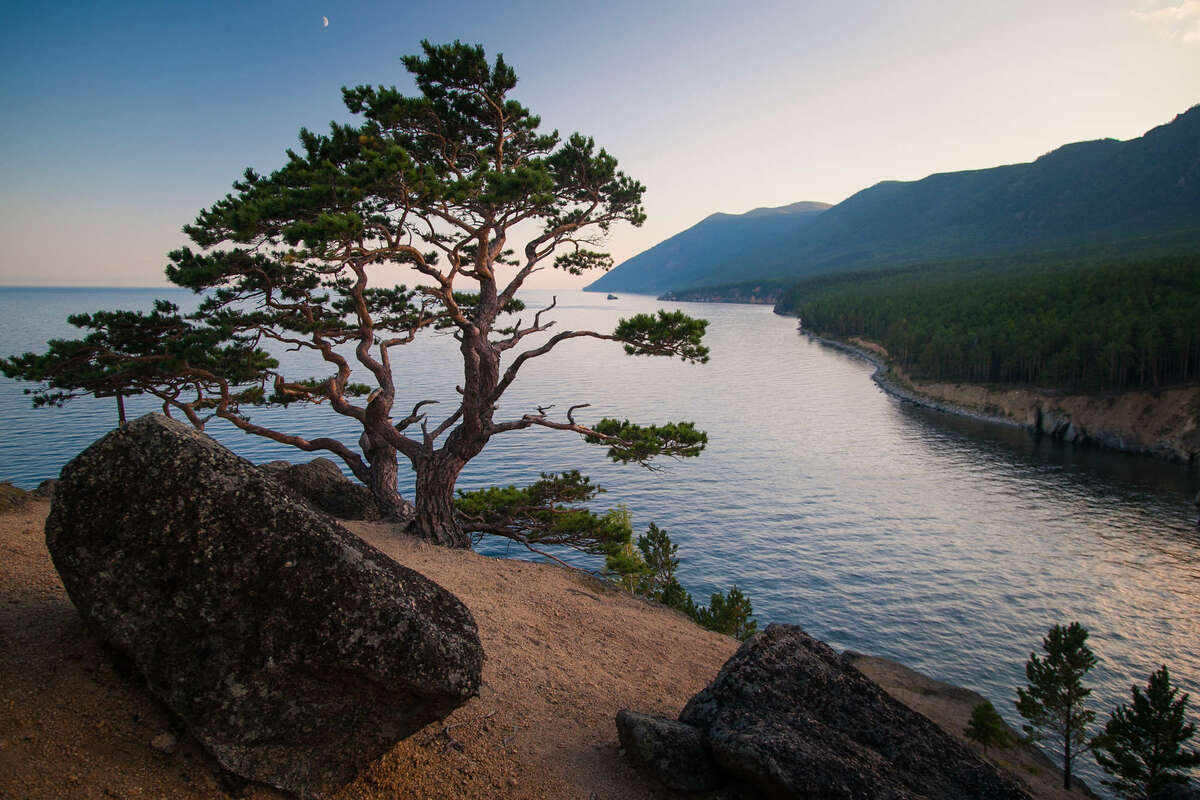
Olkhon Island is the largest island in Lake Baikal, Russia’s and the world’s largest freshwater lake. It is also one of the world’s largest lake islands, surpassed only by Manitoulin Island and René-Levasseur Island in Canada. Famous for its steep rocks, the isle is believed to be a product of a tectonic clash that created Olkhon Gate Strait, now separating the island from the lake shores.
Olkhon Island is populated mainly by its indigenous Buryat people whose language it derives its name from: oyhon means ‘wooden’ and olhan means ‘dry’, but which of the two gave the island its name is subject to much debate. Isolated and wild, a place that seems frozen in time, the island has recently seen a great influx of tourists from Russia and abroad.
The nearest international airport is in the city of Irkutsk, from which you can reach the island by road or water transport. There are no regular air routes to the island itself.
.jpg)
Olkhon Island is located in Lake Baikal and is the boundary point of the Academician Ridge. Administratively, it belongs to Russia’s Irkutsk Oblast. To reach the island, fly to Irkutsk (starts at ~$100 with departure from Moscow), then take a bus or a car to the ship pier in the village of Listvyanka or to the ferry station in the village of Sakhyurta. Note that unlike the ship, the ferry is free of charge and requires no pre-booking. Regular bus fare from Irkutsk is ~700 rubles ($11); the travel time is seven hours. In winter, the lake is completely frozen, and its ice is strong enough to sustain the weight of a car. In summer, there is also a hydrofoil service to Olkhon.
.jpg)
Olkhon Island’s 10 top-rated hotels and apart-hotels (according to Booking.com user reviews) are Mini-Hotel Diana, Shamanka, Lakeside Baikal, Star of Baikal, Volna Plus, BaikalWood Eco Lodge and Spa, Baikal View Hotel, Oazis, and Holiday Home Shiginikh, all of which offer free WiFi and great recreational facilities, from barbecuing and family lounges to spa and saunas. Amenities vary from private kitchenettes and individual showers to shared bathrooms, as do prices: there is an offer for every budget. In addition to these, there are ten more hotels, dozens of guesthouses, multiple AirBnB apartments, homestays, and country houses, as well as a couple of bed-and-breakfasts. While most of the accommodations are in Khuzhir, a few are available at other popular sites such as Khagdan Dalay.
.jpg)
There are multiple campsites on Olkhon Island, most notable being Olkhon Camping Hotel and the Horse Head Yurt Camp, as well as the Pearl of Olkhon and the Buryat Village. Prices vary; expect to pay around 800 rubles (12-13 US dollars) a day for a yurt with a meal per person. Note that due to environmental concerns, the local authorities banned informal camping almost anywhere on the island except very few special locations as well as areas the local municipalities have allocated for that purpose, such as the recreation areas in Peschanka. Tents and bonfires are forbidden on the Saraysky Beach near Khuzhir. Some of the places like Cape Ukhan and Izhimey are classified as sanctuaries and cannot be entered at all. Note that due to the same concerns, it is not allowed to ride a quad anywhere on the island.
.jpg)
Olkhon Island is a major touristic site and as such, it has quite a few cafes and restaurants, especially in Khuzhir. Prices and menu do not vary though, with the local Buryat cuisine and specifically the buuz (dumplings) being the ‘bread and butter’ of Olkhon catering. Similar cafes operate at the ferry stations both on the island and on the ‘mainland’. Elsewhere on Olkhon, prepare to provide food for yourself (and mind the campfire ban!).
.jpg)
Vaccination against tick-borne encephalitis is highly recommendable, especially in summer. Besides, while Russia does not require foreign tourists to get vaccinated before entry, the World Health Organization recommends everyone travelling to the country to be immunized against diphtheria, tetanus, measles, mumps, rubella, and polio. Rabies is sometimes encountered in Olkhon’s wild animals, so take care and exercise caution.
Russia has a universal healthcare system, and every citizen is covered by the Mandatory Health Insurance program. However, this does not apply to foreign tourists, and emergency care might really set you back, so choose your travel insurance accordingly.
Although Lake Baikal is a single reservoir that contains about a fifth of the global freshwater reserves, tap water in Russia is, unfortunately, not famous for being of good quality. While infection risks are essentially zero, chemicals such as chlorine are abundant in tap water and might not suit your taste, so bottled water is recommendable for drinking.
.jpg)
Despite being the go-to destination for wild nature enthusiasts, Olkhon Island is an incredibly child-friendly place. Many hotels here offer special services for families traveling with kids, for whom this adventure is both entertaining and educating, as they can go to the Local Lore Museum in Khuzhir to immerse in Buryat culture and life style, or pay a visit to the Buryat Village to learn the ways of indigenous people or even to try the famous buuzas—Buryat and Mongolian steamed dumplings. Cape Khoboy, Shaman Rock, and the Horse Head are the first places to take children to. Many local agencies offer package tours at family-friendly price.
.jpg)
Today, Olkhon Island is a part of the Pribaikalye National Natural Park. It is a sanctuary that has 155 bird and beast species: grouses, partridges, woodpeckers, sandpiper, ducks, larks, swifts, wagtails, lynxes, hares, red foxes, squirrels, polecats, weasels, etc., including the endemic species, the Olkhon mountain vole. There are no large predators here except wolves that might sometimes end up on the island in winter while walking the ice of Lake Baikal.
The lake has some 56 fish species (whitefish, graylings, sturgeons, perches, pikes, Siberian chars, Amur carps, catfish, etc.) and only one mammal, the Baikal seal. Excess hunting and fishing drove elks, sables, wolves, and many other species extinct here. Flora enthusiasts will be glad to visit the relic spruce forest on the western slope of Mount Zhima, a 340-ha collection of trees that has been here since the ice age. Olkhon’s forests are generally abundant in strawberries, blueberries, blackcurrant and redcurrant.
.jpg)
Perhaps the reason #1 to travel to Olkhon is the astonishing, truly scenic views of Lake Baikal that you will only get from an island in the midst of it. Next to Cape Khoboy in a bay, find the village of Uzury; another two hours of walking from here will take the traveler to the top of a mountain, a perfect stop for observing and reflecting upon the majesty of the lake, the Primorsky Ridge, and Narin Dalay, the Small Sea. It is there that you will find the miraculous Khagdan Dalay, a warm, cozy, and incredibly scenic beach. Take time and pictures to enjoy the view now and later on!
.jpg)
Shaman Rock is a cape in the middle of the west coast of Olkhon Island that has a twin-peaked rock at its very tip, hence the name. It is a state-protected natural and historical site. The cape reaches far into the waters of Lake Baikal and is only connected to the island with a narrow isthmus; crystalline limestone with quartz inclusions makes the bulk of the cape. Shaman Rock’s Buryat name, ‘Burkhan’, is the name the local Buddhists gave to the God of Baikal, whose abode, according to a legend, is in the pass-through cave in Shaman Rock.
The twin peaks themselves, also dubbed a ‘stone temple’, are one of the nine shrines of Asia. They are mainly composed of marble and limestone with graphite inserts. The near-shore peak is 30 meters high, while the further peak is as tall as 42 m. The Shaman Cave is a dozen meters long, with a ‘dragon’ being painted by Mother Nature herself—brown rock protruding from the slopes of the cliff—seen on the western side. Long believed to be the dwelling place of the local god, the cave saw many sacrificial rites on the Altar of Buddha that used to stand here. The Local Lore Museum in Khuzhir keeps many relics of the past found in the sacred grove where deceased shamans’ bodies were cremated and/or buried. The sanctity of the Shaman Cave is now for everyone to immerse in, much unlike in its time as a Buddhist-only shrine where only men (specifically, shamans) were allowed in, so don’t hesitate to take your chance to dive into the mysterious powers of balance and become one with the force.
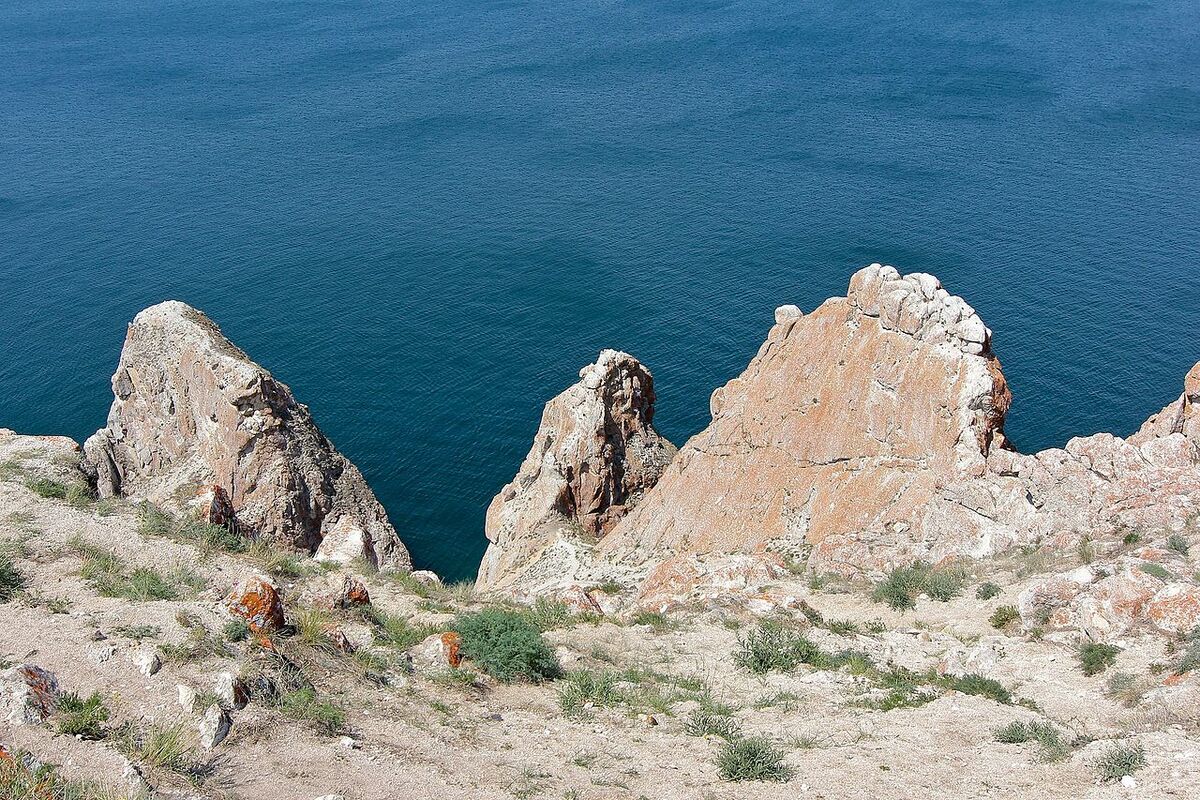
Cape Sagan-Khushun (Buryat for White Cape) is a scenic location in the northwest of Olkhon; it is a high rock massif famous for its marble-white slopes covered with bright orange and red lichen. The locals have dubbed the place Three Brothers, as these are three rocks as if deliberately ordered by height—and age. Legend has it, once upon a time there lived a shaman who had three sons and a daughter. The daughter fell in love and fled her father’s house, as the father didn’t want that relationship. He later transfigured the three brothers into eagles and sent them to find their sister. Their quest was a success, but the girl convinced the brothers not to betray her. Back home, the boys lied their father they failed the mission; he did not believe them and punished his sons by transfiguring them into rocks.
A beautiful legend, just like the place itself! No wonder it is insanely popular with tourists. There is even an observation deck at the top of the cape; however, the place is best seen from water, as only that view reveals its true magnificence. And while the ride to the rock is a rough one (and you will definitely need a SUV to reach it, for terrain is impassable for an ordinary vehicle!), it is totally worth it.
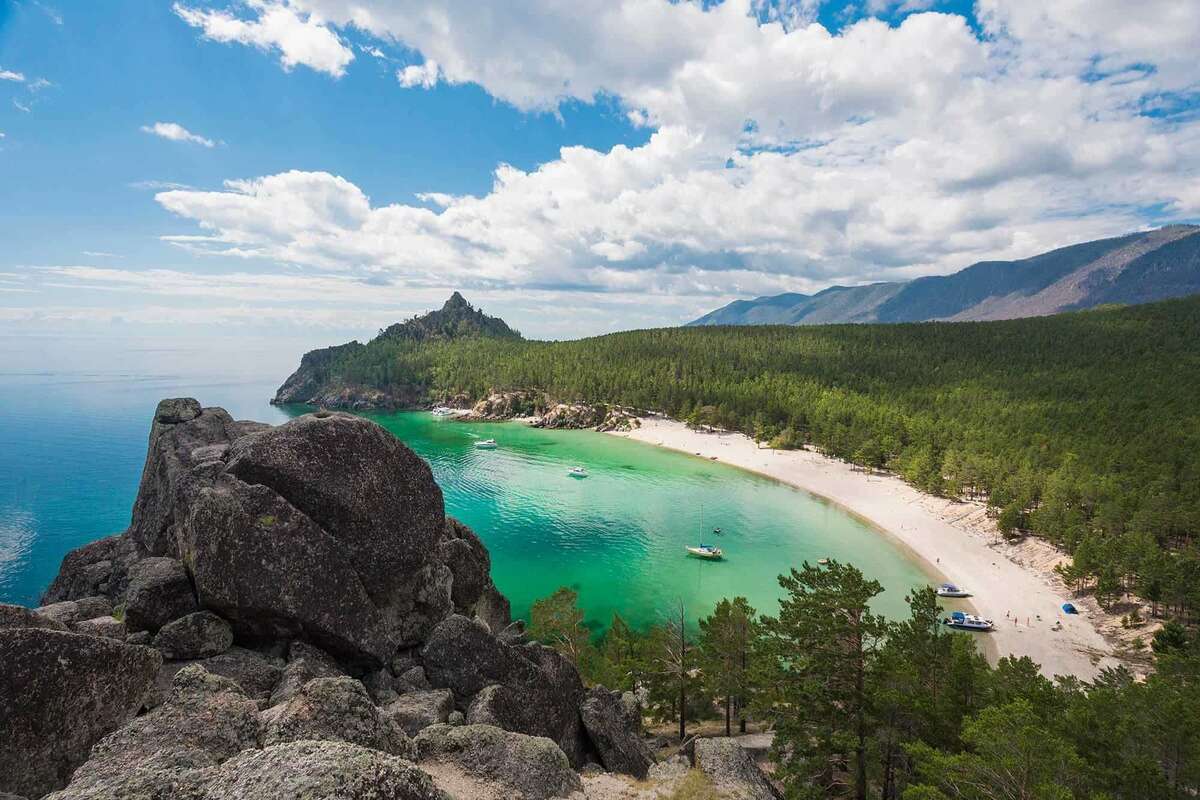
Peschanaya village, or simply Peschanka, is an abandoned settlement located 20 km north of Khuzhir. Its name means ‘sandy’ in Russian, and indeed, the sand dunes you can spot here go for a couple of kilometers into the island. This used to be a camp for prisoners who worked here at a factory producing canned fish. Now only a small pier reminds of what once was here. The pier used to have a rail track to transport ice in winter. Up to 1,200 prisoners were working in the village, mainly convicted of minor offences like pilfering. Now you’ll only see a few houses left with only one permanent resident. And while you might not be interested in stuff like prisoner labor, the place is one of the best for skinny dipping on Olkhon Island thanks to warmer waters and the sandy beach!
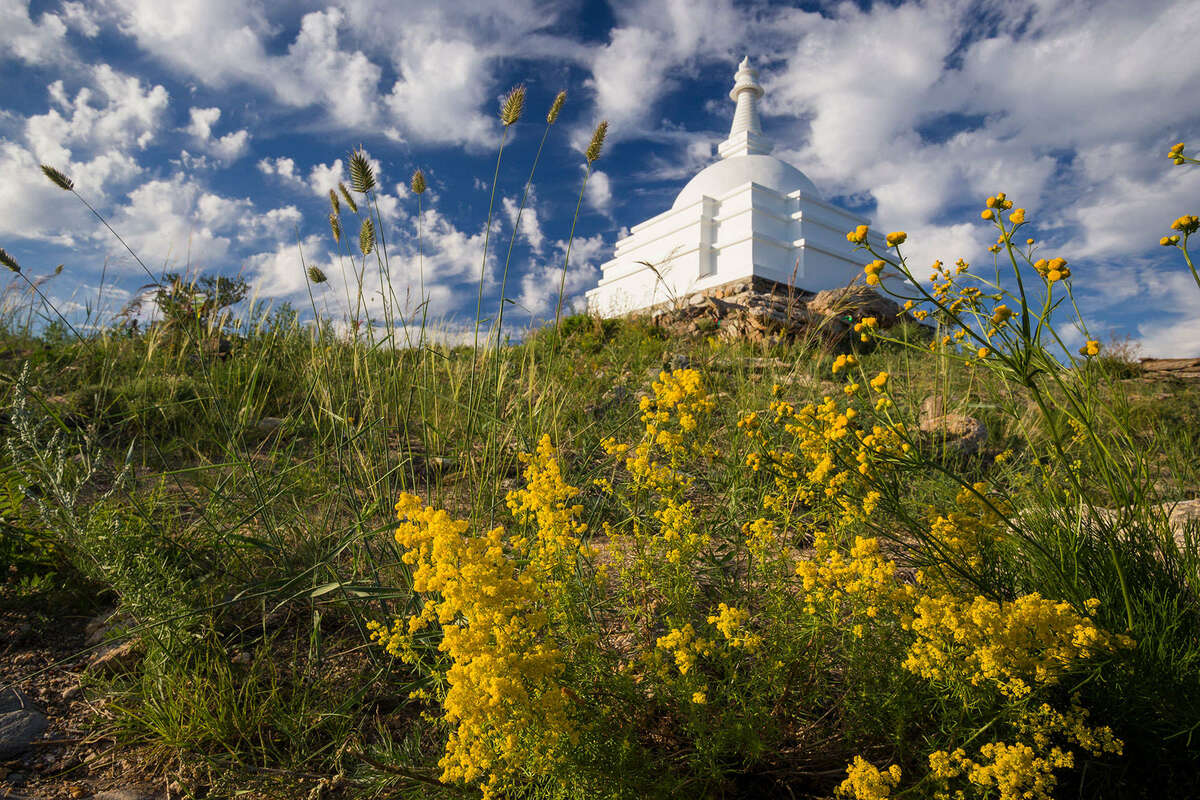
West of Olkhon Island and east of the Kurmin Bay at Lake Baikal lies Ogoy Island, a narrow piece of land that stretches for about 3 km from the north to the south. Its Cape Dragon and rocky landscapes are worthy sites in their own right; however, what brings tourists from all over the world here is the Buddhist Stupa of Enlightenment. Constructed by the Moscow Center for Buddhist, this temple dominates the highest point of the island and is dedicated to Dakini Troma Nagmo, the Mother of all Buddhas. The Stupa contains a bronze statuette of the Dakini along with a collection of other relics. The temple was blessed by the clergy of all religions: Christians, Muslims, and Buddhists came here in peace to sanctify the marble symbol of Mera Peak that Buddhists believe connects Earth, heaven, and space to link humankind to the divine realms.
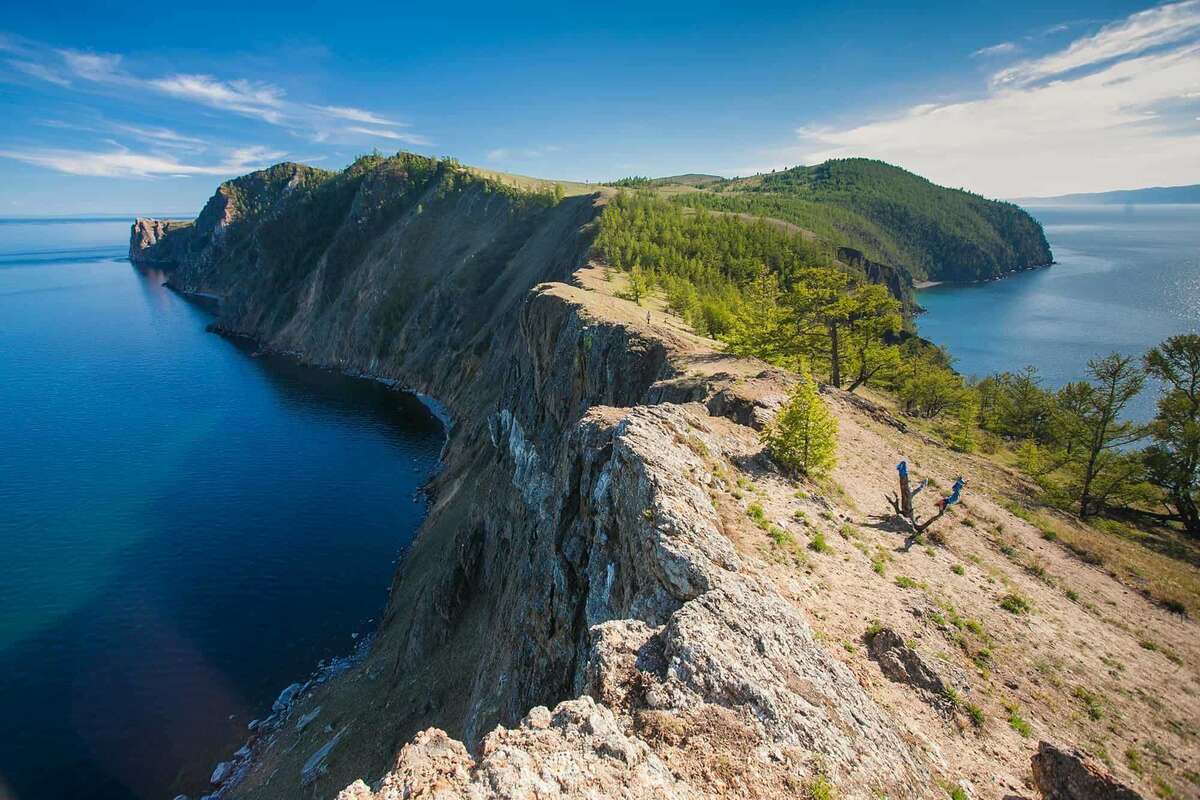
Cape Khoboy is the northernmost part of Olkhon Island. Its name means ‘fang’ in Buryat, and it matches the shape of the cape very well. On the other hand, when looking at Cape Khoboy from the waterfront, it is reminiscent of a woman’s body, hence its local nickname ‘Maiden’. A Buryat legend says the cape is a young woman who grew jealous of the palace Buryat gods gave her husband and demanded a similar one. The gods said, ‘May you be a rock for as long as there is evil and envy upon Earth’. A peculiar feature of the place is the echo, which will repeat whatever you say for an outstandingly long time.
Cape Khoboy is situated next to the widest point of Baikal; if the weather is clear, you can spot the eastern shores and the mountains of the Holy Nose peninsula. The cape is a place of power for the local shaman cult, believed to be where the first Buryat shaman was granted his powers. The rock was sacred for the indigenous people of the island and is still one of the most marvelous locations for the tourists, with its long grottos, caves, arches, relic herbs, and rare plants given the impression of a true miracle.
Below the cape and its steep eastern slope is a pebble beach, where you can set up a camp and relax enjoying the pristine wild. Magnificent and enchanting, Cape Khoboy is recognized as a landscape monument by Russia. The cape is located to the north of the village of Khuzhir and can be reached by foot.
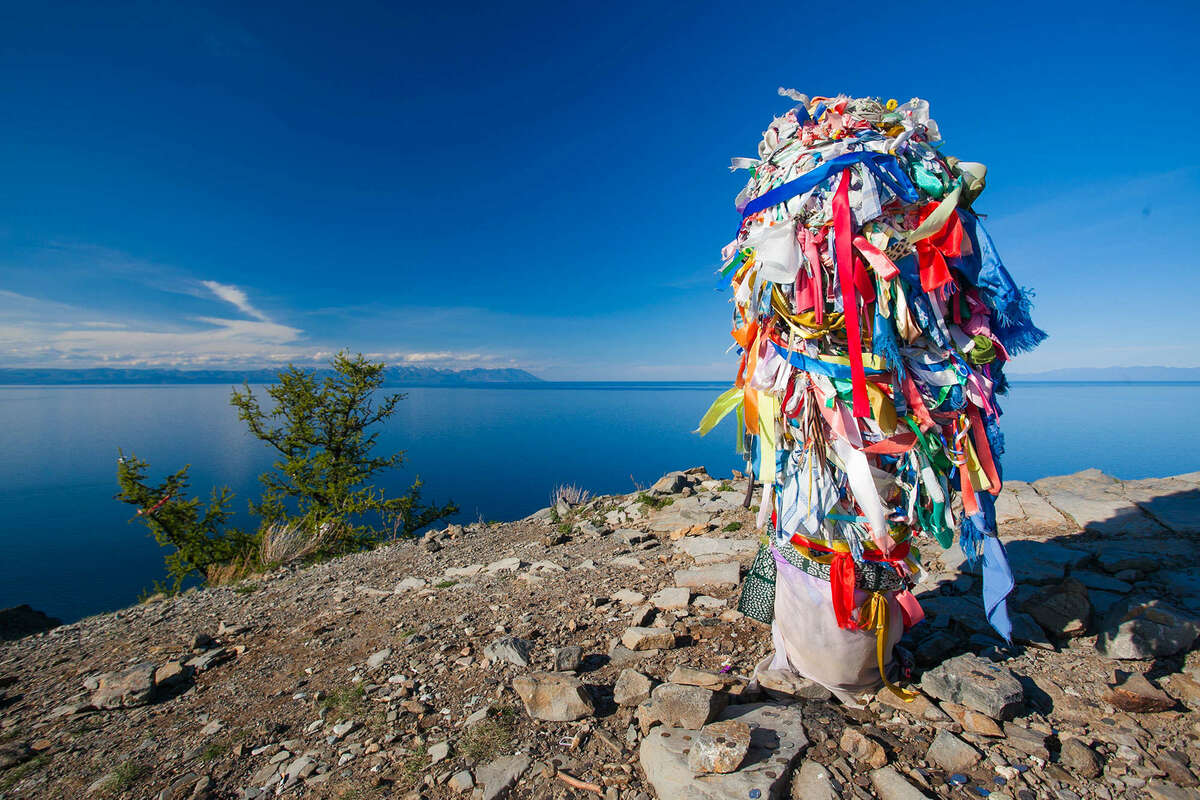
Khuzhir is a village, or, actually, a small town located on the northwestern coasts of Olkhon Island; being the largest of the nine permanent human settlements here, it is the center of attraction for tourists and businesspeople alike. Founded first in 1938 as a factory town near the fish factory, Khuzhir used to have as many as three thousand inhabitants prior to the 1960s, but then sustained a severe demographic crisis exacerbated by the closure of the factory in the 1990s. Only in the late 2000s, a booming travel and hospitality industry revived the town, which now lives and thrives on tourist dollars (well, rubles). Nearly every hotel, hostel, or homestay you will find on Olkhon Island is here in Khuzhir, as is the local tourist center that operates tours and facilities. While recreational fishing is a popular entertainment, the factory that the village was once centered around is long gone.
Khuzhir can be reached by public bus from Irkutsk or by car; a ferry connects the place to ‘mainland’ and is free of charge (note that public transport has priority pass). Up until 1990s, Khuzhir even had a small airport 6 km away near the tiny village of Kharantsy (which is itself worth visiting if you enjoy the solitude and peacefulness of a 100-man settlement lost in the wilds); however, it is currently abandoned. Khuzhir itself does not have much to see except the Revyakin Local Lore Museum, but local hotels will provide a warm and cozy shelter to relax after your adventures elsewhere on the island, be it kayaking, trekking, or fishing, while numerous souvenir shops will certainly have something for you to remember Olkhon Island by.
Olkhon Island is probably not that large, but it has plethora of things to do and is an unforgettable experience for novice and seasoned tourists alike. When there, consider the following activities:
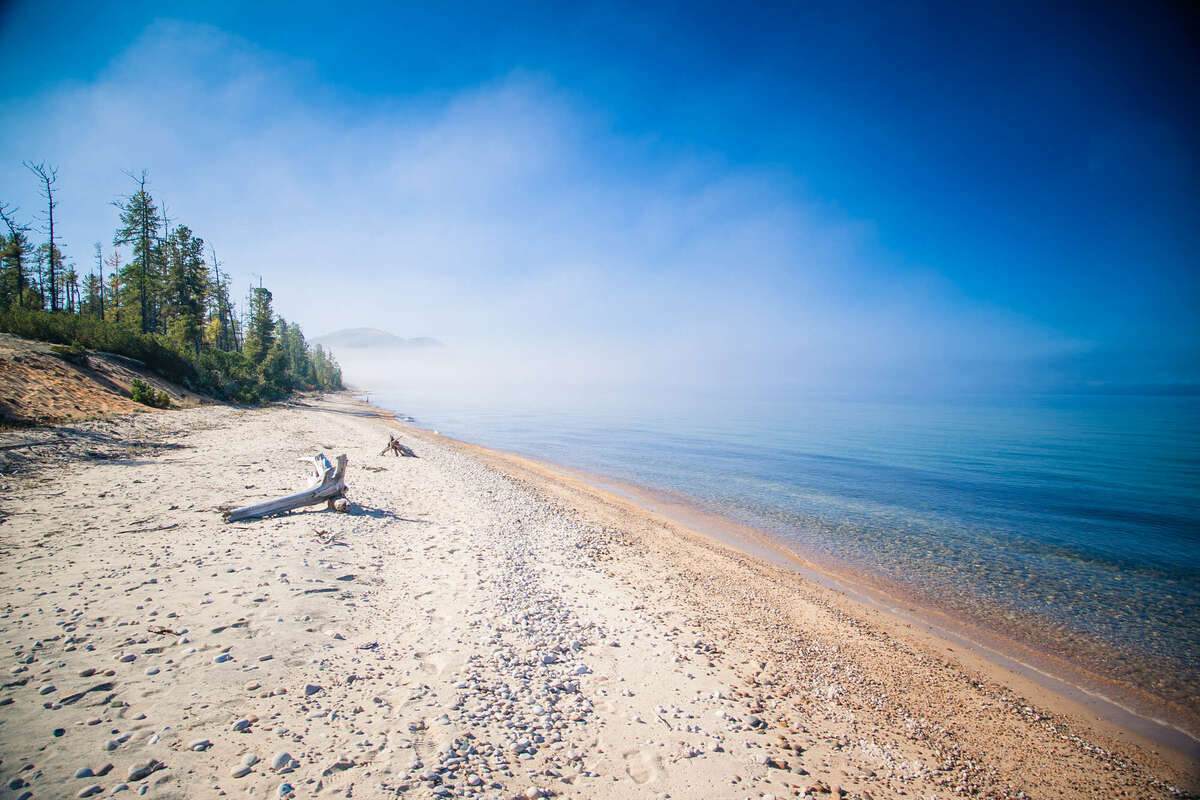
Whether you fancy Mediterranean resorts or somewhat coldish waters of North Atlantic, everyone likes the crystal-clear beauty of Lake Baikal’s waters as seen from Olkhon Island’s beaches, be it the gravel beach near cape Khoboy, the sandy dunes of Peschanka, or the island’s most popular lakeside, Saraysky. This two-kilometer beach of pure sand begins immediately northwest of Cape Burkhan and is wrapped in a scenic deciduous forest. The place is great for sunbathing in summer, but skinny dipping (or any dipping, for that matter) is not for everyone: the waters are quite cool. Swimming aside, though, there is always an option to rent a hydrocycle.
Saraysky Beach goes up to the village of Kharantsy with a small airport (for emergency landing only). The terminal now operates as a guest house. Next to it, there are two onshore yurt camping sites with an optional overnight stay.
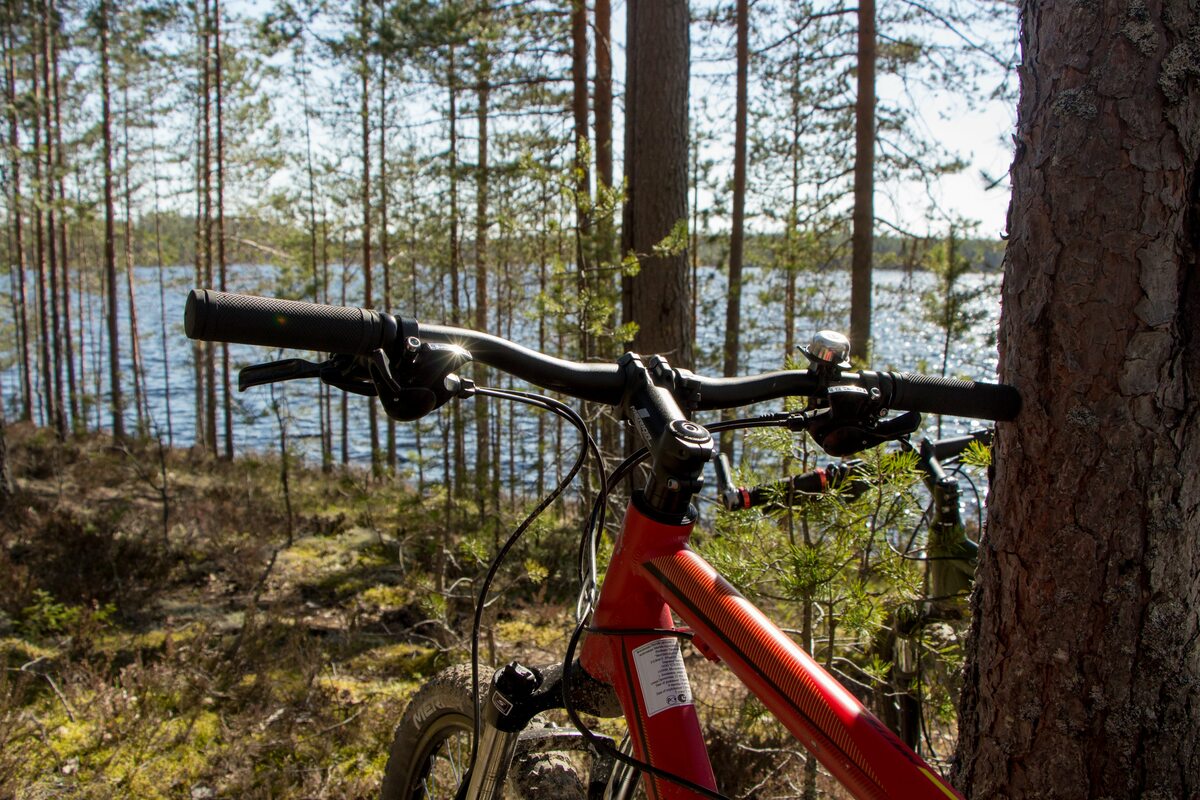
Baikal is a Proto-Borean word that means ‘place great for biking’. Jokes aside, Nikita Bencharov’s Ecological Center now offers Merida and Track mountain bikes for rent, starting at just 150 rubles (~$2.5) per day. Biking around the island on your own helps save money and the environment, and it can reach up to 65 km/h on a high-speed track. Taking water and spare underwear is advisable, better carried in a backpack. Unless you are taking a guided tour, learn some basics of how to fix your bike en route, like patching up the tires: better safe than sorry. The most popular route is Khuzhir-Khoboy: 40 km, no long uphill segments, and more-or-less decent road. Well, for most of the track.
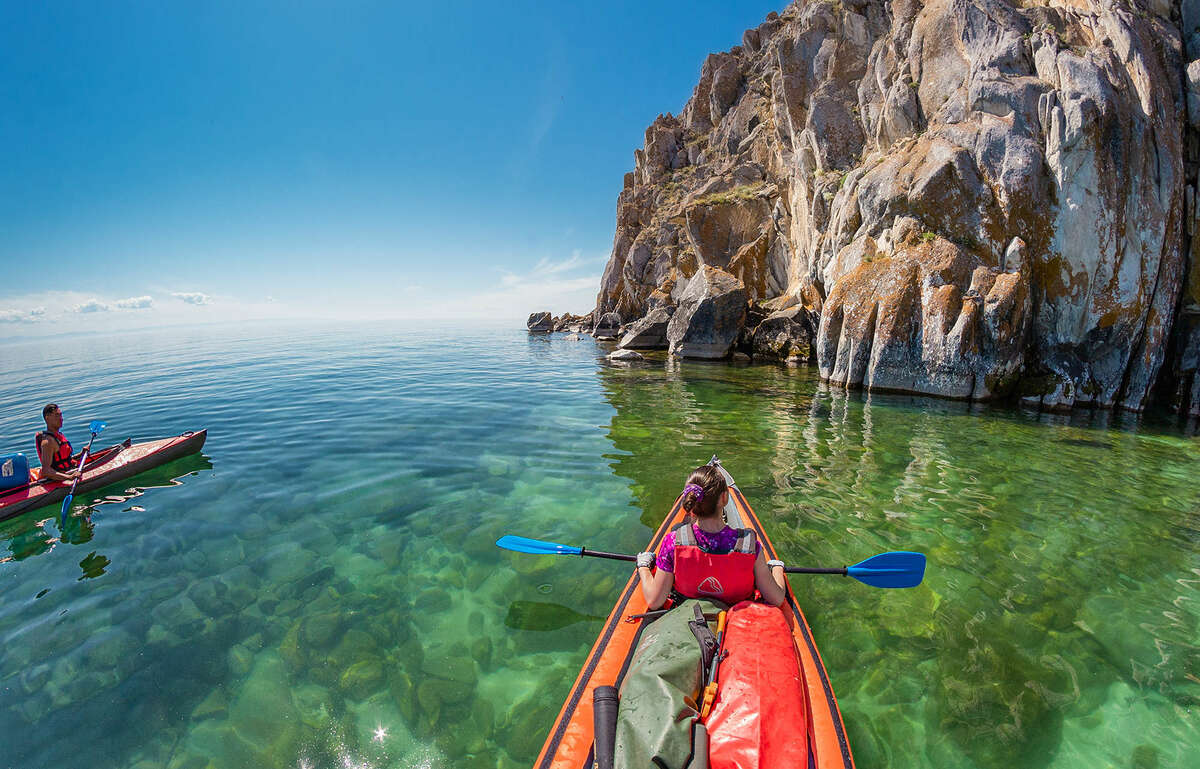
Lake Baikal is a large and scenic water body, and what large and scenic water body could go without kayaking? Indeed, what could be better than to glide the crystal-clear waters and marvel at the landscapes of Olkhon in the dusk? Guided kayak tours are offered by many local agencies that mix this activity with other active recreations, such as biking or trekking. Kayaks are available for rent from many hotels and hostels; unlike river rafting, kayaking on Lake Baikal is quite safe, as the waters are calm most of the time. Double-check the weather forecasts though.
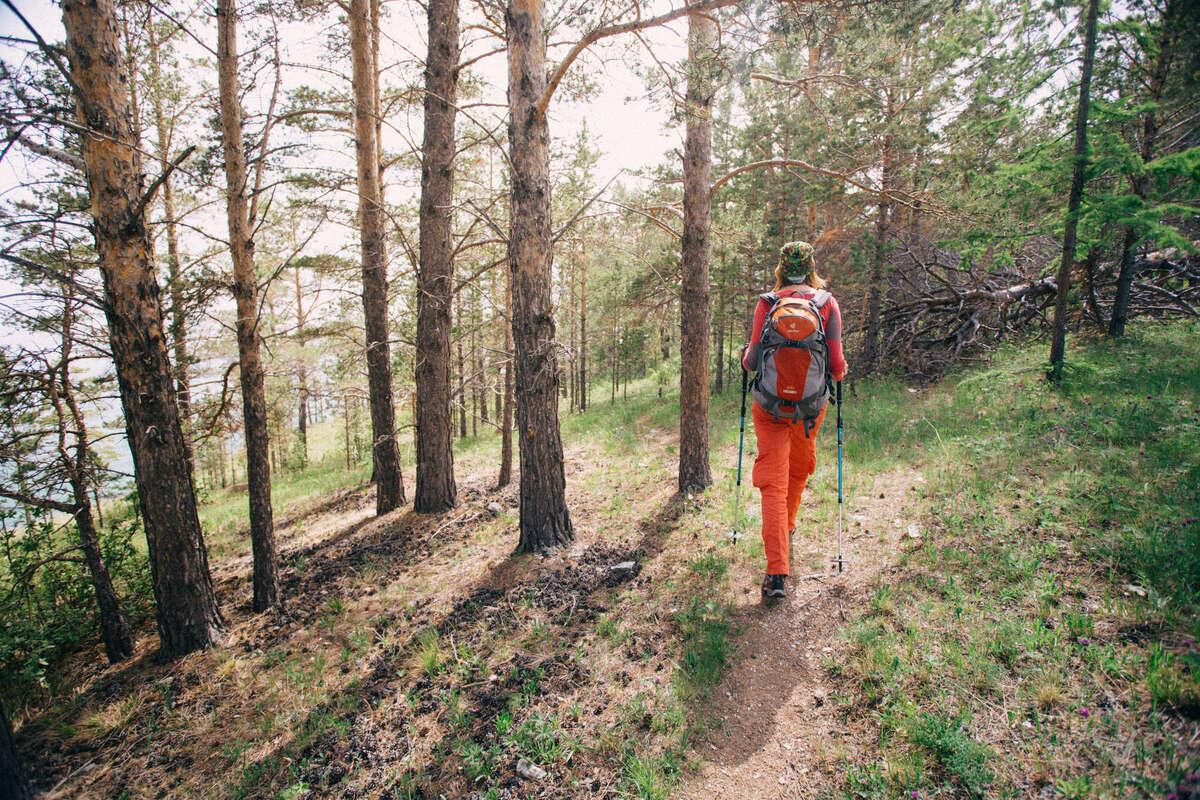
Rocky landscapes of Olkhon Island never cease to challenge those brave travelers who dare leave the safety and comfort of Khuzhir. While slopes are mostly not steep, and weather is quite fine all summer long thanks to Lake Baikal’s unique microclimate, the rugged terrain might be difficult to trek for some. Still, the views of Capes Khoboy and Burkhan are worth any physical effort — and the island, a famous place of power for shamans, will not fail to reward a mischievous adventurer whom nature and its scenery are dearer than the cozy hotel indoors.
Note that parts of the island are legally protected sanctuaries and may either require a special permit for entry or are closed for visitors. Mount Zhima is another ‘Area 51’ here: its weather station is a staff-only facility. And do not forget about camping restrictions. All popular sites, from Khuzhir to Peschanka, can be visited over a one-day trekking tour; bringing cooked food is recommendable, as fires are forbidden in most of the island.
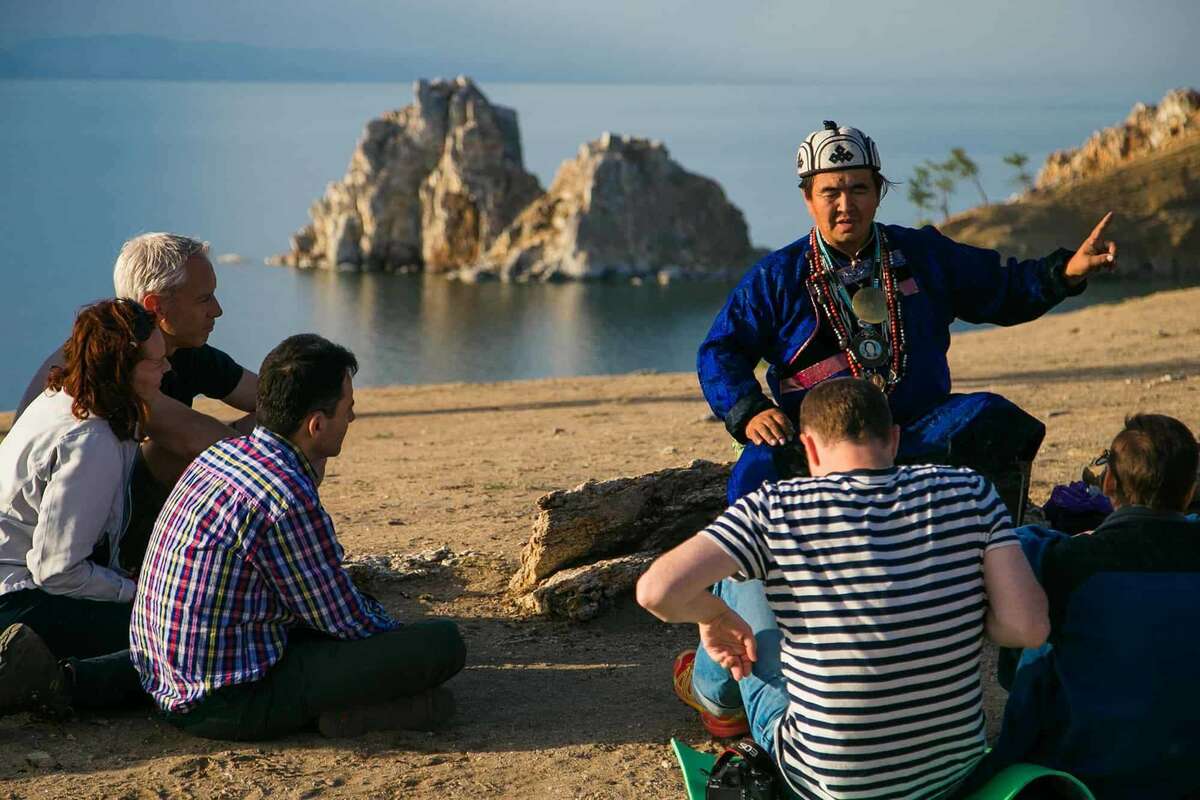
Olkhon Island is sacred to Buryat shamans; remember Shaman Rock with its shaman-only cave? There are many more sites that the locals venerate above all; these so-called places of power might be as simple as totem poles or as complex and sophisticated as the Stupa of Enlightenment. To go to Olkhon Island means to tame the wilderness of Mother Nature, and what can help you more on that cause than the shamanist relics of the past?
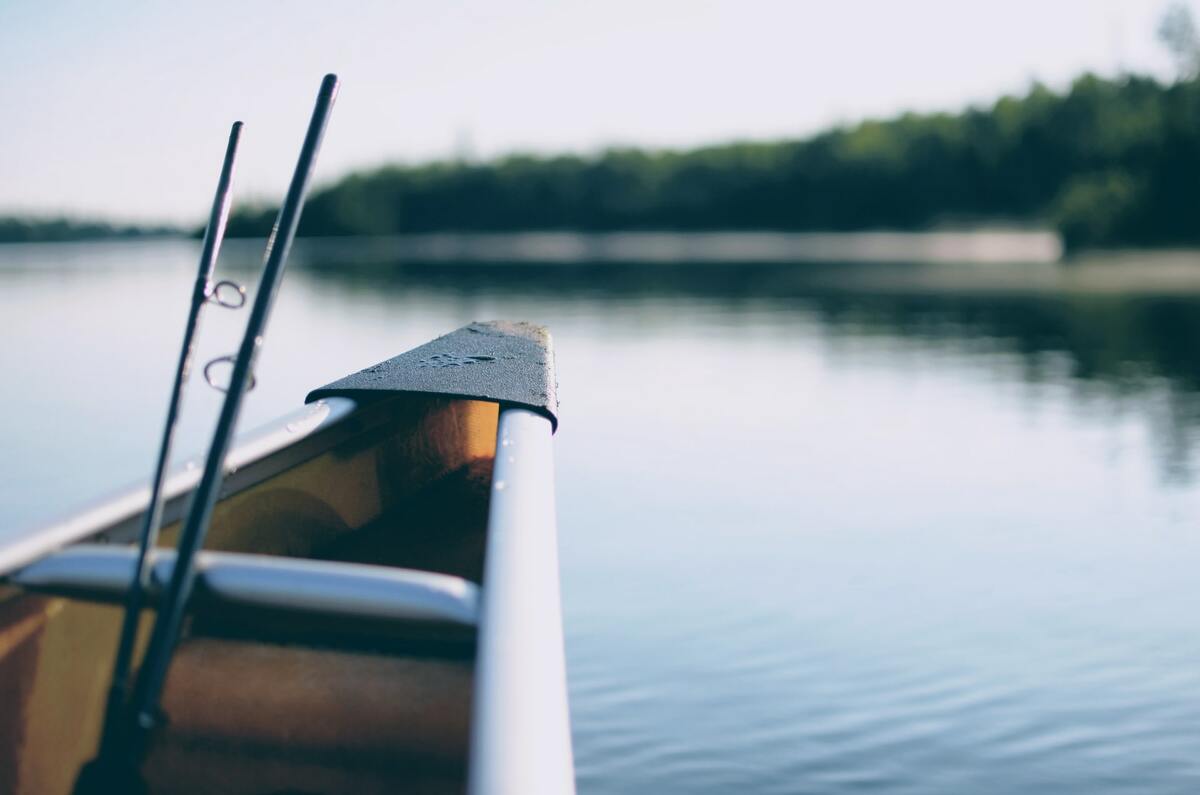
Recreational fishing is probably not everyone’s cup of tea, but is nonetheless an increasingly popular leisure activity. Lake Baikal has always been rich in fish, so rich the Soviets opened a fish factory on Olkhon Island (now limited to the production of omul). Small Sea alone has 40 fish species. And no, you don’t have to buy your own fishing gear: whatever you might need is available for rent. Needless to say small-scale fishing for personal consumption requires no licensing or special permits. The most popular fishing sites are the Small Sea and the Zagli Bay (which also happens to be the arrival point of a scheduled ship from Irkutsk).
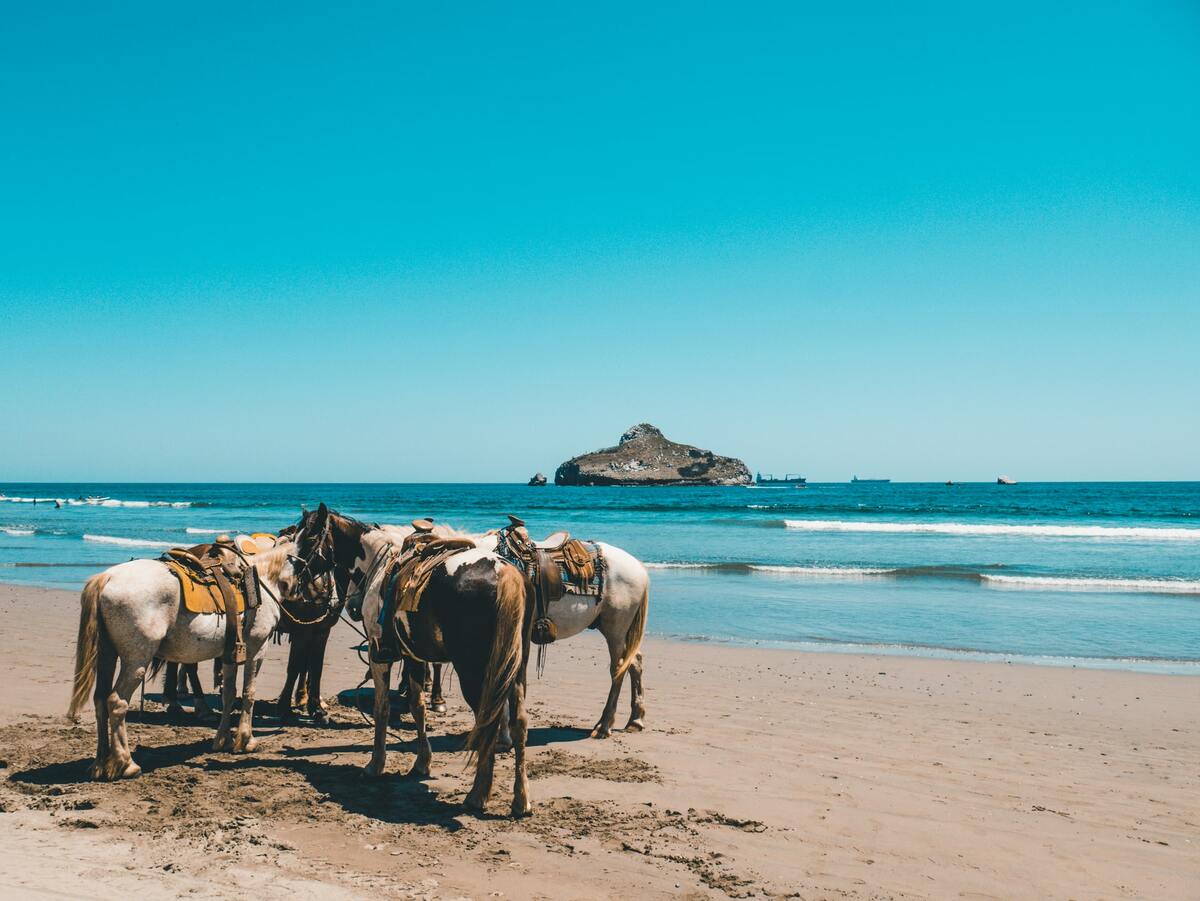
There is something special, something magical about horseback riding. This little healthy form of entertainment is available in Khuzhir, Olkhon Island, where an experienced guide will help you choose a route according to your riding skills and will accompany you on your journey. Necessary briefing for novices (how to get onto the horseback and how not to fall from it) provided on the spot. Children aged 10 or older are allowed to ride; however, children are somewhat at risk, as horseback riding is never 100% safe. Riding under the influence of alcohol or drugs is forbidden; for outfit, choose comfortable workout pants and shoes.